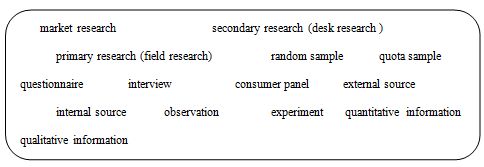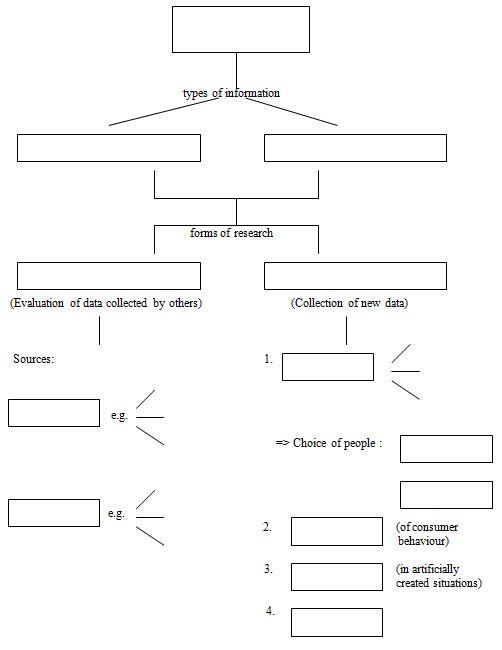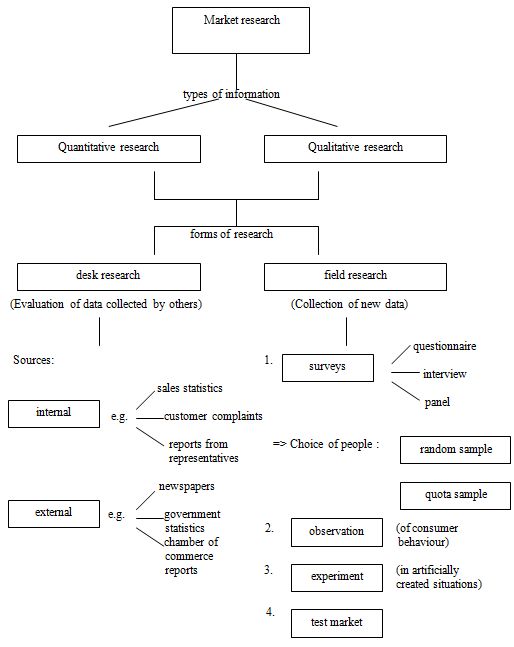Marktforschung
Market research
Your task:
- Read the text about market research
- Underline the key words
- Complete the following structure with the key words
- Categorize the key words
Keywords:

keywords
| I understood | Please explain again |
Market research is the systematic process of gathering information about a market, analysing it and interpreting it. It can be either qualitative or quantitative. In qualitative research, small group discussions in-depth interviews with consumers are used to understand a problem better. Quantitative research involves collecting, or gathering large samples of data, followed by statistical analysis.
Methods of market research
A company who wants to get information on any given market has two ways of gathering the required information. First the company manufacturer will try to find out as much as possible from sources that are already available to him. This form of research is called secondary research (or desk research) because it uses information that was originally compiled by others. A lot of internal data will come from the company itself: sales statistics showing how well certain products have been selling in certain areas and periods, reports from sales staff and representatives about customer satisfaction, and enquiries or complaints from customers. External sources of information which can be analysed by desk research are, for example, government statistics or reports from banks, chambers of commerce and trade associations on certain countries or markets. The media (newspapers, magazines, radio, television, online services) provide up-to-date information. It is also possible to buy complete market surveys from market research institutes or other manufacturers. Secondary research is often a much cheaper way of gathering information as the research has already been done by others.
Primary research in contrast is the collection of original data. It involves direct contact with potential or existing customers. This research will usually have been planned and carried out by the people who want to use the data; it is first-hand. It can be an expensive way to gather information and will usually be for a specific purpose, for example, to test the market to see if a new product would be likely to succeed. Primary research is very expensive and it is usually carried out by specialised market research institutes. The methods of primary market research are representative surveys, observations, experiments and test markets. Representative surveys are carried out in a similar way to opinion polls.
Questionnaires form the basis of most primary research. Questionnaires may be conducted face-to-face, for example in the street, by telephone or by mail. Deciding what questions to ask is difficult if you want to be sure of getting accurate results. Some questions may not be very clear, some questions may lead the respondents to answer in a certain way which may not be what they really think. The researcher also needs to decide who to ask. When interviews are used, the interviewer (the person asking the questions) will have ready-prepared questions for the interviewee (the person answering the questions). In consumer panels groups of people agree to provide information about a specific product or general spending patterns over a period of time. Panels may also test new products and then discuss what they think of them, explaining what they like and what they dislike about them. From a sample of only about a thousand surveys market researchers can reliably predict the behaviour of all the consumers in a certain country or market. A random sample is when people are selected at random as a source of information for market research. A quota sample is when people are selected on the basis of certain characteristics (e.g. age, gender or income) as a source of information for market research.
Observations of consumer behaviour can be made in supermarkets, for example. Researchers have found out by observation that shelves on the right-hand-side attract more attention (because people push their trolleys with their left hand and use their right hand to take the goods). This can take the form of: recording, watching and audits.
Experiments are carried out in artificially created situations. In a well-known experiment coffee drinkers were given coffee from packs in different designs and colours and asked which one tasted best – the coffee was the same, of course, and the object of the experiment was to find out which design was the most attractive.
A test market is carried out in a small area. The product will be introduced there and sales are thoroughly observed. If a product fails in a test market, the manufacturer can avoid the high costs of introducing it everywhere. West Berlin was a popular test market before German reunification because of its isolated location.
market research - structure

Arbeitsblatt: Marketreasearch Structure
market research - structure

Lösung: Marketreasearch Structure
Weiter zu Produkt
